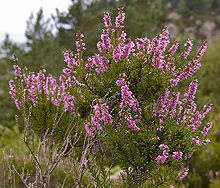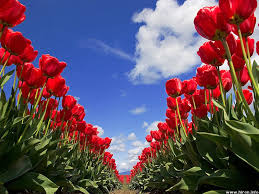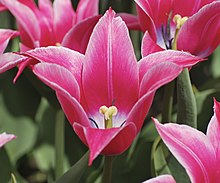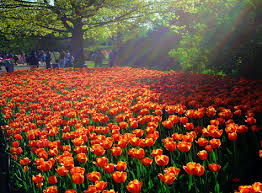Red Roses................
Friday, May 17, 2013
Tuesday, May 14, 2013
Calluna (Heathers)
Calluna (Heathers)
Calluna vulgaris (known as common heather, ling, or simply heather) is the sole species in the genus Calluna in the family Ericaceae. It is a low-growing perennial shrub growing to 20 to 50 centimetres (7.9 to 20 in) tall, or rarely to 1 metre (39 in) and taller, and is found widely in Europe and Asia Minor on acidic soils in open sunny situations and in moderate shade. It is the dominant plant in most heathland and moorland in Europe, and in some bog vegetation and acidic pine and oak woodland. It is tolerant of grazing and regenerates following occasional burning, and is often managed in nature reserves and grouse moors by sheep or cattle grazing, and also by light burning.
Referred to as Erica in all the old references, Calluna was separated from the closely related genus Erica by Richard Anthony Salisbury, who devised the generic name Calluna from the Greek kallunein, "beautify, sweep clean", in reference to its traditional use in besoms. The specific epithet vulgaris is Latin for 'common'. Calluna is differentiated from Erica by its corolla and calyx each being in four parts instead of five. Calluna has small scale-leaves (less than 2–3 mm long) borne in opposite and decussate pairs, whereas those of Erica are generally larger and in whorls of 3-4, sometimes 5.[3] The flowers emerge in late summer; in wild plants these are normally mauve, but white-flowered plants also occur occasionally. Unlike Erica, Calluna sometimes sports double flowers. Calluna is sometimes referred to as Summer (or Autumn) heather to distinguish it from Erica (Winter (or Spring) heather).
Kingdom: Plantae
Clade: Angiosperms
Clade: Eudicots
Clade: Asterids
Order: Ericales
Family: Ericaceae
Genus: Calluna


Uses
Heather is an important food source for various sheep and deer which can graze the tips of the plants when snow covers low-growing vegetation. Willow Grouse and Red Grouse feed on the young shoots and seeds of this plant. Both adult and larva of the Heather Beetle Lochmaea suturalis feed on it, and can cause extensive mortality in some instances. The larvae of a number of Lepidoptera species also feed on the plant, notably the small emperor moth Saturnia pavonia.
Formerly heather was used to dye wool yellow and to tan leather. With malt, heather is an ingredient in gruit, a mixture of flavourings used in the brewing of heather-beer during the Middle Ages before the use of hops. Thomas Pennant wrote in A Tour in Scotland (1769) that on the Scottish island of Islay "ale is frequently made of the young tops of heath, mixing two thirds of that plant with one of malt, sometimes adding hops". The use of heather in the brewing of modern heather beer is carefully regulated. By law[specify], the heather must be cleaned carefully before brewing, as the undersides of the leaves may contain a dusting of an ergot-like fungus, which is a hallucinogenic intoxicant.[citation needed]
Heather honey is a highly valued product in moorland and heathland areas, with many beehives being moved there in late summer. Not always as valued as it is today, it was dismissed as mel improbum by Dioscurides. Heather honey has a characteristic strong taste, and an unusual texture, for it is thixotropic, being a jelly until stirred, when it becomes a syrup like other honey, but then sets again to a jelly. This makes the extraction of the honey from the comb difficult, and it is therefore often sold as comb honey.
White heather is regarded in Scotland as being lucky,a tradition brought from Balmoral to England by Queen Victoria and sprigs of it are often sold as a charm and worked into bridal bouquets.

Tulip
The tulip is a perennial, bulbous plant with showy flowers in the genus Tulipa, of which up to 109 species have been described and which belongs to the family Liliaceae. The genus's native range extends from as far west as Southern Europe, Anatolia (Turkey), Israel, Palestine, North Africa, and Iran to the Northwest of China. The tulip's centre of diversity is in the Pamir, Hindu Kush, and Tien Shan mountains. A number of species and many hybrid cultivars are grown in gardens, as potted plants, or to be displayed as fresh-cut flowers. Most cultivars of tulip are derived from Tulipa gesneriana.
Kingdom: Plantae
Division: Angiosperms
Order: Liliales
Family: Liliaceae
Subfamily: Lilioideae
Genus: Tulipa






Cultivation
Tulips are indigenous to mountainous areas with temperate climates and need a period of cool dormancy, known as vernalization. They thrive in climates with long, cool springs and dry summers. Although perennials, tulip bulbs are often imported to warm-winter areas of the world from cold-winter areas, and are planted in the fall to be treated as annuals.
Tulip bulbs are typically planted around late summer and fall, in well-drained soils, normally from 4 inches (10 cm) to 8 inches (20 cm) deep, depending on the type planted. In parts of the world that do not have long cool springs and dry summers, the bulbs are often planted up to 12 inches (30 cm) deep. This provides some insulation from the heat of summer, and tends to encourage the plants to regenerate one large, floriferous bulb each year, instead of many smaller, non-blooming ones.[citation needed] This can extend the life of a tulip plant in warmer-winter areas by a few years, but it does not stave off degradation in bulb size and the eventual death of the plant due to the lack of vernalization.






Kingdom: Plantae
Division: Angiosperms
Order: Liliales
Family: Liliaceae
Subfamily: Lilioideae
Genus: Tulipa

Cultivation
Tulips are indigenous to mountainous areas with temperate climates and need a period of cool dormancy, known as vernalization. They thrive in climates with long, cool springs and dry summers. Although perennials, tulip bulbs are often imported to warm-winter areas of the world from cold-winter areas, and are planted in the fall to be treated as annuals.
Tulip bulbs are typically planted around late summer and fall, in well-drained soils, normally from 4 inches (10 cm) to 8 inches (20 cm) deep, depending on the type planted. In parts of the world that do not have long cool springs and dry summers, the bulbs are often planted up to 12 inches (30 cm) deep. This provides some insulation from the heat of summer, and tends to encourage the plants to regenerate one large, floriferous bulb each year, instead of many smaller, non-blooming ones.[citation needed] This can extend the life of a tulip plant in warmer-winter areas by a few years, but it does not stave off degradation in bulb size and the eventual death of the plant due to the lack of vernalization.



Sunday, May 12, 2013
Bougainvillea
Bougainvillea
Bougainvillea also known as Napoleón (Honduras), veranera (Colombia, Nicaragua, El Salvador, Costa Rica and Panama), trinitaria (Colombia, Cuba, Panama, Puerto Rico, Dominican Republic & Venezuela), Santa Rita (Argentina, Bolivia, Paraguay and Uruguay) or papelillo (northern Peru)) is a genus of flowering plants native to South America from Brazil west to Perú and south to southern Argentina (Chubut Province). Different authors accept between four and 18 species in the genus.
They are thorny, woody vines growing anywhere from 1 to 12 metres (3 ft 3 in to 39 ft 4 in) tall, scrambling over other plants with their spiky thorns. The thorns are tipped with a black, waxy substance. They are evergreen where rainfall occurs all year, or deciduous if there is a dry season. The leaves are alternate, simple ovate-acuminate, 4–13 cm long and 2–6 cm broad. The actual flower of the plant is small and generally white, but each cluster of three flowers is surrounded by three or six bracts with the bright colours associated with the plant, including pink, magenta, purple, red, orange, white, or yellow. Bougainvillea glabra is sometimes referred to as "paper flower" because the bracts are thin and papery. The fruit is a narrow five-lobed achene.
Bougainvillea are relatively pest-free plants, but may suffer from worms, snails and aphids. The larvae of some Lepidoptera species also use them as food plants, for example the giant leopard moth (Hypercompe scribonia).
Kingdom: Plantae
(unranked): Angiosperms
(unranked): Eudicots
(unranked): Core eudicots
Order: Caryophyllales
Family: Nyctaginaceae
Tribe: Bougainvilleeae
Genus: Bougainvillea
History
The first European to describe these plants was Philibert Commerçon, a French botanist accompanying French Navy admiral and explorer Louis Antoine de Bougainville during his voyage of circumnavigation, and first published for him by Antoine Laurent de Jussieu in 1789. It is possible that the first European to observe these plants was Jeanne Baré, Commerçon's lover and assistant whom he sneaked on board (despite regulations) disguised as a man (and who thus became the first woman to circumnavigate the globe).
Twenty years after Commerçon's discovery, it was first published as 'Buginvillea' in Genera Plantarum by A.L. de Jusseau in 1789. The genus was subsequently spelt in several ways until it was finally corrected to 'Bougainvillea' in the Index Kewensis in the 1930s. Originally, B. spectabilis and B. glabra were hardly differentiated until the mid-1980s when botanists recognized them to be totally distinct species. In the early 19th century, these two species were the first to be introduced into Europe, and soon, nurseries in France and England did a thriving trade providing specimens to Australia and other faraway countries. Meanwhile, Kew Gardens distributed plants it had propagated to British colonies throughout the world. Soon thereafter, an important event in the history of bougainvillea took place with the discovery of a crimson specimen in Cartagena, Colombia, by Mrs. R.V. Butt. Originally thought to be a distinct species, it was named B. buttiana in her honour. However, it was later discovered to be a natural hybrid of a variety of B. glabra and possibly B. peruviana - a "local pink bougainvillea" from Peru. Natural hybrids were soon found to be common occurrences all over the world. For instance, around the 1930s, when the three species were grown together, many hybrid crosses were created almost spontaneously in East Africa, India, the Canary Islands, Australia, North America, and the Philippines.
Cultivation and uses
Bougainvilleas are popular ornamental plants in most areas with warm climates. Locarno in Switzerland, with its mild Mediterranean climate, is famous for its bougainvilleas.[citation needed]
Although it is frost-sensitive and hardy in U.S. Hardiness Zones 9b and 10, bougainvillea can be used as a houseplant or hanging basket in cooler climates. In the landscape, it makes an excellent hot season plant, and its drought tolerance makes it ideal for warm climates year-round. Its high salt tolerance makes it a natural choice for color in coastal regions. It can be pruned into a standard, but is also grown along fence lines, on walls, in containers and hanging baskets, and as a hedge or an accent plant. Its long arching thorny branches bear heart-shaped leaves and masses of papery bracts in white, pink, orange, purple, and burgundy. Many cultivars, including double-flowered and variegated, are available.
Many of today's bougainvillea are the result of interbreeding among only three out of the eighteen South American species recognized by botanists. Currently, there are over 300 varieties of bougainvillea around the world. Because many of the hybrids have been crossed over several generations, it is difficult to identify their respective origins. Natural mutations seem to occur spontaneously throughout the world; wherever large numbers of plants are being produced, bud-sports will occur. This had led to multiple names for the same cultivar (or variety) and has added to the confusion over the names of bougainvillea cultivars.
The growth rate of bougainvilleas varies from slow to rapid, depending on the variety. They tend to flower all year round in equatorial regions. Elsewhere, they are seasonal, with bloom cycles typically four to six weeks. Bougainvilleas grow best in dry soil in very bright full sun and with frequent fertilization; but they require little water once established, and in fact will not flourish if over-watered. As indoor houseplants in temperate regions, they can be kept small by bonsai techniques. They can be easily propagated via tip cuttings.
The hybrid cultivar B. buttiana 'Poulton's Special' has gained the Royal Horticultural Society's Award of Garden Merit.
Subscribe to:
Posts (Atom)


